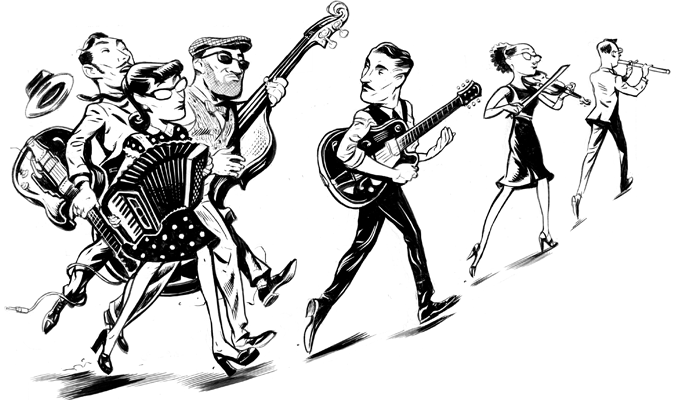The secret recipe for organizational culture is no recipe
Culture emerges from a variety of ingredients within your organization, and cookie-cutter approaches won’t get it right.

Imagine a chocolate chip cookie. Better yet, get one. Take a bite. Savor the flavor and texture. What makes a chocolate chip cookie so delicious? Save for the chocolate chips, most of the ingredients aren’t that appealing on their own. Few people reach for a big spoonful of flour to satisfy a craving. Other ingredients are not obvious except to bakers: salt, vanilla, baking soda. Yet each is essential to the final product.
This cookie exercise, first shown to me by leadership consultant Margaret Wheatley at a workshop, is an excellent (and delectable) demonstration of the emergent properties of a system: The whole has characteristics not found in any of the individual elements that comprise it. This point is helpful in beginning to explore organizational culture. To understand why a culture is either working or in need of repair, you have to understand the whole and the parts. Your organization’s culture emerges from the unique combination of your people, principles, policies, and practices — all of them — in your distinct operational context.
The events of the past year have many leaders concerned that the cookie is crumbling. Pandemic-induced disruption within workforces has seemed to weaken culture as a unifying organizational force. And because culture emerges, it is difficult to remedy this weakening or other ills by importing “best” practices from one organization to another — simply appropriating admirable principles or practices on innovation, for example, will not yield the same result, because the people and operating environment will be different. Thus, the cookie metaphor only takes us so far.
A cookie is a bounded and, once baked, static system. If you combine specific ingredients in precise amounts and prepare them according to exact directions, you will get a generally predictable result. By contrast, organizations are complex, adaptive systems. They are always in some state of flux as people come and go, investor and customer demands shift, technologies arise, and so on. This makes culture impossible to dictate from the top, and as a result, culture is less a matter of following a recipe than mastering the craft of baking so you spot challenges and opportunities early and are able to adapt. If you have ever seen the segments on cooking competition shows in which the contestants are given five random ingredients and told to create something wonderful on a deadline, you get the idea. There is no recipe, per se, though there is a method.
Here are five actions leaders can take to coax a beneficial culture out of the unique ingredients within your organization.
Culture is less a matter of following a recipe than mastering the craft of baking so you spot challenges and opportunities early and are able to adapt.
See the system. Cookies are a reminder that everything in your organization is connected — and that culture emerges from the interactions between the whole and the parts. Culture can’t actually “eat strategy for breakfast,” as management guru Peter Drucker used to say, because the two are inseparable — ideally, each reflects and amplifies the other. To get a clearer sense of your organization’s system, chart your employee and customer experiences. Try something similar with the “how an idea becomes a solution” journey in different parts of the organization. Those system maps can reveal many of the steps and touch points that help define your culture, for better or worse. Take, for example, a company that micromanages every second of a customer service representative’s time and compare that company to shoe retailer Zappos, where it’s expected that every employee will “help even when it isn’t their job” and “go above and beyond what’s expected in every interaction” with all stakeholders. The former has a top-down, control-focused culture, and the latter empowers employees and encourages initiative. Every single activity in your organization presents an opportunity to craft the culture you want.
Accentuate the positive and articulate the negative. It is essential to have a clear and compelling vision of what you want your culture to become. You also have to acknowledge where you have been and be clear-eyed about where you are. When setting goals around diversity and inclusion, for example, it is important to be realistic about why you have not been more diverse and inclusive to date. Ask yourself what you have done, explicitly and implicitly, to create your current state. Once you have this information, you can engage in the unlearning and relearning necessary to get where you hope to go.
See culture as a living system. I find the “simple rules” approach to strategy valuable when discussing culture. It holds that organizations function best with a few steadfast parameters to guide activity, but with abundant freedom within those parameters to be creative in achieving goals — much as jazz musicians improvise while hewing to the boundaries of an agreed-upon melody. This approach encourages the right balance of convergence and divergence. According to creative strategist Michelle Holliday, all living systems navigate this tension. Large organizations should seek alignment around “shared purpose, identity, and an organizational narrative that endure even as people come and go,” she told me. Simultaneously, she said, these organizations need to encourage variability in microcultures in different departments and geographic locations, for example. Done well, the mix of convergence and divergence fosters both coherence and adaptability for a “self-organizing, self-healing, regenerative” culture well-suited to handling disruption and change.
Make culture an ongoing journey. Organizations are dynamic and so are their cultures. Netflix, one of the organizations I’ve studied that is most intentional in expressing its culture, evolves its famous “culture deck,” which outlines the principles of its culture, along with the business. Every new hire goes through an intense introduction to the culture as part of the onboarding process. The culture principles then are criteria in daily decision-making, and culture is treated as alive, not a plaque on the wall. The deck’s current iteration states, “We do not seek to preserve our culture — we seek to improve it. Every person who joins us helps to shape and evolve the culture further.” According to Holliday, culture evolution can be messy, though that is not a bad thing. The alternative — typically prescriptive approaches that tightly define relationships and processes — encourage rigid, mechanistic thinking and are ill-suited to unleashing the potential of people to solve complex challenges and confront fast-changing circumstances.
Take change all the way to the top. Barry O’Reilly, a consultant who helps organizations with innovation, told me that a barrier to invention he commonly encounters is that senior executives often embrace the idea of change for others, yet are not ready to change themselves — and then are surprised when change falters. People in positions of power send signals that resonate throughout the culture. Therefore, top executives should admit what they need to do differently to encourage the culture they desire. “The single most important action of any leader is to model the behaviors they wish to see others exhibit in the organization,” O’Reilly told me. “Culture change does not lead with words — it leads with action. If executives don’t adapt their behavior and action, people see the whole effort as a hoax.”
At a time of accelerating change, a robust and resilient culture is an invaluable asset to rapidly overcoming obstacles and identifying opportunities. Cookies are a great conversation starter, but slice-and-bake solutions aren’t good enough. Start a dialogue throughout your organization about what people love about your culture and what they’d like to change, and you’ll begin understanding the unique ingredients for your company’s ideal culture recipe.





